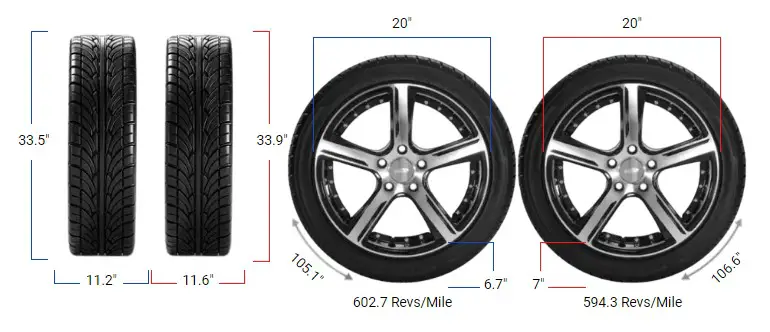Tire Size 285/60R20 vs 295/60R20

Switching from 285/60R20 to 295/60R20 tires is generally feasible, as the diameter difference falls within the acceptable 3% range. This change results in a slightly wider tire with a minimal increase in overall diameter. While the switch offers some benefits, it also comes with potential drawbacks that drivers should consider before making the change.
- Diameter increase of 1.4% is within the acceptable range
- Wider tread offers improved traction and stability
- Slight increase in ground clearance may benefit off-road performance
- Minor impact on speedometer accuracy and fuel efficiency
The primary distinction between 285/60R20 and 295/60R20 tires lies in their width. The 295/60R20 is 10mm (0.39 inches) wider than the 285/60R20, representing a 3.5% increase in width. This change affects the tire’s footprint, potentially altering handling characteristics and traction.
Fitment Guide
When considering a tire size change, it’s crucial to adhere to the fitment guide. In this case, the diameter difference between the 285/60R20 and 295/60R20 tires is 1.4%, well within the acceptable range of 3%. This means the interchange is generally recommended without requiring significant adaptations.
On-Road Impact
Evaluates tire performance, comfort, and handling on paved surfaces. Highlights how 285/60R20 and 295/60R20 tires affect driving experience and stability on roads.
- Traction & Stability: The wider 295/60R20 tire provides a larger contact patch with the road, potentially improving traction and stability during cornering and braking. This can enhance overall handling, especially in dry conditions.
- Ride Comfort: The slight increase in sidewall height (0.24 inches) may contribute to a marginally softer ride, absorbing road imperfections more effectively. However, this difference is minimal and may not be noticeable to most drivers.
- Speedometer Accuracy: The 1.4% increase in diameter results in a small discrepancy in speedometer readings. At 20 mph, the actual speed will be 20.28 mph. While this difference is minor, it’s worth noting for those who prioritize precise speed measurements.
- Fuel Efficiency: The wider tires may slightly increase rolling resistance, potentially leading to a marginal decrease in fuel efficiency. However, the impact is likely to be negligible in real-world driving conditions.
- Noise Levels: Wider tires can sometimes generate more road noise due to increased surface contact. However, the difference between these two sizes is relatively small, so any change in noise levels may be minimal.
Off-Road Impact
Assesses traction, durability, and performance on rugged terrain. Compares the capabilities of 285/60R20 and 295/60R20 tires in off-road conditions for adventurous drives.
- Ground Clearance: The 0.47-inch increase in diameter translates to a slight boost in ground clearance. This can be beneficial for off-road enthusiasts, providing a bit more obstacle clearance and reducing the risk of undercarriage damage.
- Traction in Loose Terrain: The wider tread of the 295/60R20 tire can offer improved traction in soft surfaces like sand or mud. The larger footprint helps distribute the vehicle’s weight more evenly, reducing the likelihood of sinking or getting stuck.
- Flotation: In deep snow or sandy conditions, the wider tire may provide better flotation, helping the vehicle stay on top of soft surfaces rather than sinking in.
Durability & Wear
Tread Life: The minor increase in tire diameter results in slightly fewer revolutions per mile (8.39 fewer). This could theoretically lead to marginally slower tread wear, but the difference is likely negligible in practice.
Load Capacity: The wider tire may offer a slight increase in load-carrying capacity, which can be beneficial for vehicles that frequently carry heavy loads or tow trailers.
Our Observation
Switching from 285/60R20 to 295/60R20 tires offers a blend of subtle benefits and potential drawbacks. The wider tread provides improved traction and stability, enhancing on-road performance and off-road capability.
The slight increase in ground clearance is advantageous for light off-roading. However, these benefits come with minor trade-offs, such as potential fitment issues and a marginal impact on fuel efficiency.
For most drivers, the differences in on-road performance will be negligible, while off-road enthusiasts may appreciate the small gains in traction and clearance. Ultimately, the decision to switch should be based on individual needs and vehicle compatibility.
Will switching to 295/60R20 tires affect my vehicle’s warranty?
A: It may, depending on your vehicle manufacturer. Always consult your owner’s manual or dealer before making tire size changes.
Do I need to recalibrate my speedometer after switching to 295/60R20 tires?
A: While the speed difference is minimal (1.4%), some drivers may choose to recalibrate for precise readings. Consult a professional for guidance.
Will the wider tires improve my vehicle’s handling?
A: The wider tires may offer slightly improved cornering stability and dry traction, but the difference may not be noticeable in everyday driving.
Can I expect better fuel economy with the new tire size?
A: The change in fuel economy is likely to be negligible. Other factors, such as driving habits and maintenance, have a more significant impact on fuel efficiency.
Will the new tires fit my existing wheels?
A: The 295/60R20 tires should fit on wheels designed for 285/60R20 tires, but it’s crucial to verify wheel compatibility and vehicle clearance before making the switch.
Related Article

Meet Caitlin McCormack, a Tire Size Expert and Blogger Passionate About Everything Related to Tires. With Years of Experience in the Tire Industry, Caitlin Has Become an Expert in Tire Sizes and Their Impact on Vehicle Performance.
